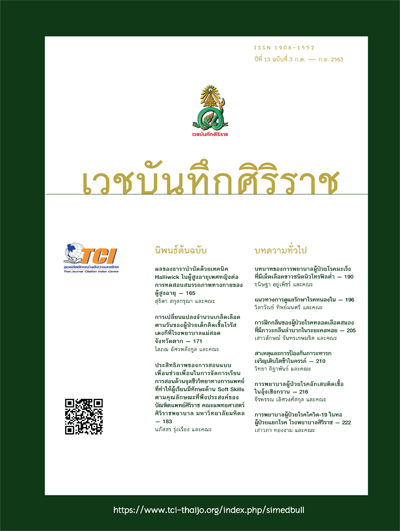แนวทางการดูแลรักษาโรคหนองในเฉพาะที่
Main Article Content
Abstract
Gonorrhea has been listed as one of the most concerned sexually transmitted infections (STI) by the World Health organization. This is in line with the situation in Thailand in that the rising incidence of gonorrhea cases has been observed from 2012-2016. The explanations include resistance potential of Neisseria gonorrhoeae, partly asymptomatic nature of the disease, expensive diagnostic tools, inadequate treatment and poor follow-up. Cephalosporin is the main treatment regimen; however, there are recently reported cases of its resistance. One of the cases is an English man who had sexual relation with a Thai woman. As an index case of STI is like the tip of iceberg, the story affects many treatment guidelines of gonorrhea in that the dosage of cephalosporin must be doubled from the beginning. Likewise, Thailand has launched the new treatment guideline in 2019. The article aims to update knowledge relating to gonorrhea in all aspects.
Article Details
References
2. Centers for Disease Control and Prevention. Reported STDs in the United States, 2015 National data for Chlamydia, Gonorrhea, and Syphilis. October 2018.
3. ภัทรชัย กีรติสิน, บรรณาธิการ. วิทยแบคทีเรียการแพทย์. พิมพ์ครั้งที่ 1. กรุงเทพมหานคร, โรงพิมพ์วีเจพริ้นติ้ง; 2549. หน้า 367-73.
4. Bennett JE, Dolin R, Blaser MJ, editors. Mandell, Douglas, and Bennett’s principles and practice of infectious diseases. Vol 2. 8th ed. Philadelphia (PA): Churchill Livingstone, Elsevier; 2015.
5. Centers for Disease Control and Prevention. Sexually transmitted diseases treatment guidelines, 2015. MMWR Recomm Rep 2015;64:1-137.
6. De LaTorre IG, Zavala AN. Gonococcal and Nongonococcal Arthritis. Rheum Dis Clin North Am
2009;35:63-73.
7. Unemo M. Current and future antimicrobial treatment of gonorrhea – the rapidly evolving Neisseria gonorrhoeae continues to challenge. BMC Infect Dis 2015;15:364-78.
8. Committee on Gynecologic Practice. ACOG Committee Opinion No.645: Dual Therapy for Gonococcal Infections. Obstet Gynecol 2015;126:e95-9.
9. รสพร กิตติเยาวมาลย์, ศุภโชค คงเทียน, บรรณาธิการ. แนวทางการดูแลรักษาโรคหนองใน พ.ศ. 2562. พิมพ์ครั้งที่ 1. กรุงเทพมหานคร: โรงพิมพ์อักษรกราฟฟิคแอนด์ดีไซน์; 2562.
10. Bhide A, Nama V, Patel S, Kalu E. Microbiology of cysts/abscesses of Bartholin’s gland: Review of empirical antibiotic therapy against microbial culture. J Obstet Gynaecol 2010;30:701-3.
11. Lanjouw E, Ouburg S, de Vries HJ, Stray A, Radcliffe K, Unemo M. 2015 European guideline on the management of Chlamydia trachomatis infections. Int J STD AIDS 2016;27:333-48.
12. Kirkcaldy RD, Bolan GA, Wasserheit JN. Cephalosporin-Resistant Gonorrhea in North America. JAMA 2013;309:185-7.


